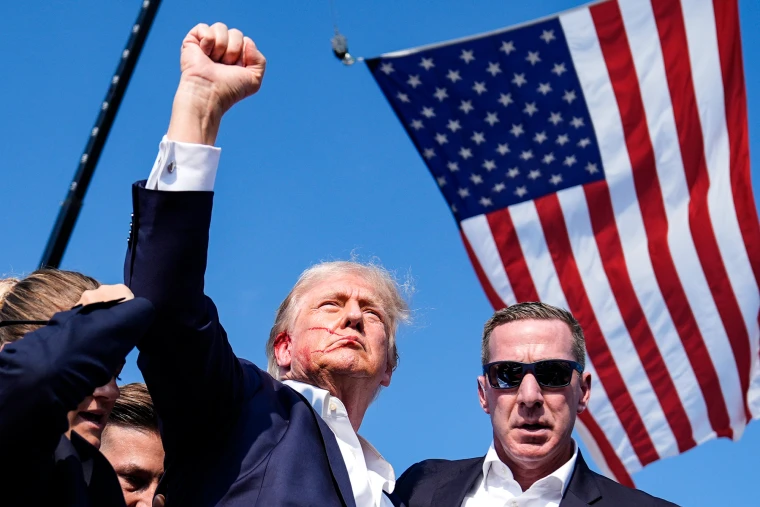Disclaimer: This article is a collection of my immediate reactions and considerations in light of the recent assassination attempt on former President Donald Trump. The narrative is still developing, and new information may emerge that could alter the understanding of the events described herein. Readers are encouraged to stay updated with the latest information and form their own conclusions based on a thorough examination of the evidence.
A Coordinated Inside Job?
In light of the recent assassination attempt on former President Donald Trump, several glaring lapses in the Secret Service’s response have raised serious concerns. Are these failures just the byproduct of incompetence or part of a coordinated attempt by an entrenched bureaucrats, supported by domestic intelligence agencies and the Five Eyes intelligence network?
What’s Weird
Shooter’s Background and Radical Extremism
The shooter, identified as Thomas Matthew Crooks, had connections with Antifa protests from 2018-2020 and beyond that he might have had a part in coordinating. This loosely organized radical left-wing extremist network has been known for its consistent violent tactics and extreme rhetoric. The mainstream media’s continuous use of corporate propaganda to compare Trump to Hitler has only fueled this radicalism, pushing individuals like Crooks to take drastic measures.
Infiltration of the Republican Party
Interestingly, Crooks was registered with the Republican Party, which allows only registered members to vote in Pennsylvania’s closed primaries. This registration, just a day after he donated to the Biden campaign, suggests a strategic move to infiltrate the Republican primary process and prevent Trump’s nomination; something that was frequently discussed as an effective strategy in left-wing circles in the months leading up to the state primaries. The New Hampshire Primary had media coverage that documented this reality thoroughly
Secret Service Failures
The Secret Service’s response time raises significant red flags:
- Delayed Human Shield Formation: All shots were fired in the three seconds it took for agents to surround Trump, a critical delay in such a high-stakes situation that resulted in both harm to the president and excess injury and death to the audience.
- SWAT Response Time: The tactical team’s 26-second response time seems excessively long as they didnt deploy until the initial threat was neutralized. If another threat had been a genuine concern, the secondary threat actor would have had ample time to act in the time between first shots fired and the tactical teams presence on scene.
- Pre-emptive Action: Eyewitnesses reported seeing the shooter with a rifle minutes before the attack, yet no pre-emptive action was taken by secret service.
- Line of Sight: Allowing a clear line of sight from the rooftop to the stage violated standard procedures, which should have included blocking such vantage points.
These lapses suggest more than just negligence; they hint at possible coordination from within.
A Coordinated Effort?
Given the shooter’s background, the suspicious timing of his actions, and lack of effective coordinated response, it’s plausible that this was a coordinated attempt to remove Trump; orchestrated by those within the government who oppose his policies. The shadow government, with its deep ties to intelligence networks, has the access and tools needed to facilitate such an attempt and has in the past radicalized individuals and provided them with he tools to engage in violence.
The Overton Window and Left-Wing Extremism
This incident is another example of the left’s growing extremism and its attempt to control public discourse. The radicalization of individuals through extreme media rhetoric has pushed the Overton Window further left, normalizing violence against political opponents. For a detailed analysis of this phenomenon, refer to our article on “The Shifting Overton Window” on ItsChromo.com.
It’s Happened Before
Instances where the FBI has been accused of using assets to engage in online conversations with individuals, radicalize them, and provide tools for terrorism:
1. The Case of Sami Osmakac (2012)
- Background: Sami Osmakac, a naturalized U.S. citizen from Kosovo, was arrested for plotting an attack in Tampa, Florida.
- FBI Involvement: Osmakac came under the FBI’s radar after expressing extremist views to an informant. The FBI introduced an undercover agent who posed as an arms dealer.
- Radicalization and Tools: The undercover agent provided Osmakac with inert explosives and firearms.
- Outcome: Osmakac was arrested after attempting to carry out the attack. Critics argued that the FBI played a significant role in shaping Osmakac’s plot and providing the means to execute it.
2. The Case of the Cleveland 5 (2012)
- Background: Five men were arrested for plotting to blow up a bridge in Ohio.
- FBI Involvement: The men were initially involved in Occupy Wall Street protests. An FBI informant befriended them and suggested escalating their actions.
- Radicalization and Tools: The informant provided the group with fake explosives and the idea to target a bridge.
- Outcome: The men were arrested after attempting to detonate the fake explosives. Critics contended that the FBI informant played a crucial role in the development of the plot and the group’s decision to carry it out.
3. The Case of James Cromitie (2009)
- Background: James Cromitie and three other men were arrested for plotting to bomb synagogues and shoot down military planes.
- FBI Involvement: Cromitie was approached by an FBI informant who offered financial incentives and introduced the idea of the plot.
- Radicalization and Tools: The informant provided fake bombs and a missile launcher.
- Outcome: Cromitie and his accomplices were arrested after attempting to carry out the plot. Critics argued that the FBI’s informant played a significant role in instigating and facilitating the plot.
4. The Case of Rezwan Ferdaus (2011)
- Background: Rezwan Ferdaus was arrested for plotting to attack the Pentagon and U.S. Capitol with remote-controlled aircraft.
- FBI Involvement: An FBI informant contacted Ferdaus after he expressed interest in jihadist activities online.
- Radicalization and Tools: The FBI provided fake explosives and a remote-controlled aircraft.
- Outcome: Ferdaus was arrested after attempting to execute his plan. Critics claimed that the FBI heavily influenced Ferdaus’ actions and provided the necessary tools for the plot.
5. The Case of Mohamed Osman Mohamud (2010)
- Background: Mohamed Osman Mohamud was arrested for attempting to detonate a bomb at a Christmas tree lighting ceremony in Portland, Oregon.
- FBI Involvement: The FBI monitored Mohamud’s online activities and introduced undercover agents who posed as like-minded individuals.
- Radicalization and Tools: The undercover agents provided a fake bomb and guidance on executing the attack.
- Outcome: Mohamud was arrested after trying to detonate the fake bomb. Critics argued that the FBI’s undercover agents played a substantial role in radicalizing Mohamud and facilitating the plot.
A Real Concern
The assassination attempt on Trump reveals a disturbing trend of left-wing fascistic extremism, fueled by a shadow government seeking to maintain control. This event is a stark reminder of the lengths to which these forces will go to suppress dissent and manipulate the political process. As we move forward, it’s crucial to remain vigilant and question the narratives being pushed by those in power.
Read More: Understanding False Flags and Government Manipulation
Delve deeper into the history and concept of false flags, and explore how the US federal government has, at times, engaged in manipulative practices. Here are some reputable sources that provide detailed information and historical examples:
- False Flags and Government Deception
- False Flag: How the U.S. Government’s Use of False Flag Operations Can Lead to Misguided War – A detailed examination of false flag operation North Woods, the DoD plan to engage in Terrist attacks on civilians within the US and blame it on Cuban radicals Wikipedia.
- “Manufacturing Consent: The Political Economy of the Mass Media” by Edward S. Herman and Noam Chomsky – This book explores how governments and large organizations can influence and manipulate public perception through media.
- Historical Examples of False Flags
- The Gulf of Tonkin Incident – This event, which led to the escalation of the Vietnam War, is widely considered to have been misrepresented to the public. Read more on National Security Archive and History.com.
- Operation Northwoods – A proposed operation by the U.S. Department of Defense for conducting acts of terrorism against American civilians and military targets, intended to be blamed on Cuba. Detailed documents can be found on The National Security Archive.
- Government Lies and Manipulation
- “Legacy of Ashes: The History of the CIA” by Tim Weiner – This book provides an in-depth look at the CIA’s history, including instances of deception and manipulation.
- Church Committee Reports (1975-1976) – Official reports from the U.S. Senate committee that investigated abuses by the CIA, NSA, FBI, and IRS. These reports detail various covert operations and manipulations. Available on Senate.gov.
- Understanding Media and Public Perception
- “Propaganda” by Edward Bernays – A foundational text on the techniques of public relations and manipulation, explaining how public opinion can be shaped by powerful entities.
- “The Shock Doctrine: The Rise of Disaster Capitalism” by Naomi Klein – This book discusses how governments and corporations exploit crises to push through controversial policies, often using manipulative tactics.
Read More: Understanding Manchurian Candidates and the Creation of Political Assassins
For those interested in exploring the concept of Manchurian candidates and the reality of creating political assassins, here are some reputable sources that provide in-depth information and historical context:
- Historical Background and Concepts
- “The Manchurian Candidate” by Richard Condon – This novel, which popularized the term, delves into the concept of brainwashed political assassins. While fictional, it provides a starting point for understanding the cultural impact.
- “Programmed to Kill: The Politics of Serial Murder” by David McGowan – This book explores the dark underbelly of political assassinations and mind control.
- Government Programs and Experiments
- Project MKUltra – The CIA’s mind control program aimed at developing techniques for brainwashing and psychological manipulation. Official documents and reports can be found on The National Security Archive, And Here and CIA.gov.
- “The Search for the ‘Manchurian Candidate’: The CIA and Mind Control” by John D. Marks – This book provides a detailed investigation into the CIA’s MKUltra program and other mind control experiments.
- Case Studies and Investigations
- The Assassination of Robert F. Kennedy – Sirhan Sirhan, the convicted assassin, has claimed to have been under mind control. Detailed analysis and ongoing investigations are covered in various reports, including articles from Court House News and The Washington Post, And Here.
- “Operation Artichoke” – An earlier CIA project focused on interrogation techniques and the development of mind control. Documentation can be found on CIA Documents and through Freedom of Information Act (FOIA) requests Summary.
- Scientific and Psychological Perspectives
- “The Control of Candy Jones” by Donald Bain – This book tells the story of a woman allegedly brainwashed by the CIA to become a courier and assassin.
- “Mind Wars: Brain Science and the Military in the 21st Century” by Jonathan D. Moreno – This book examines the intersection of neuroscience and military applications, including mind control and psychological manipulation.
- Academic Reports
- “Brainwashing: The Science of Thought Control” by Kathleen Taylor – An academic perspective on the techniques and ethics of brainwashing and thought control.


Leave a Reply